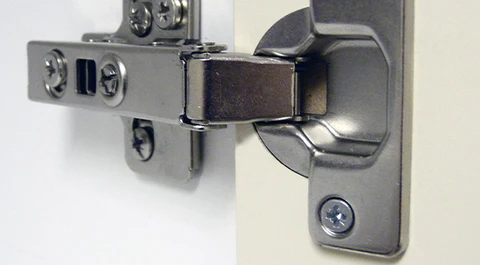Concealed Cabinet Hinges
Concealed Cabinet hinges are available in a range of specifications, designed for awkward spaces as well as standard opening cupboard doors.
Typically found in Kitchens, the hinges can be used to make the most of storage spaces behind a door, creating a sanitary and aesthetically pleasing environment. The three most common applications for concealed hinges are Full overlay, Part overlay and Inset overlay.
- Full Overlay – When closed, the cupboard door conceals the carcass frame behind it making the door the feature (typically used in most modern kitchens).
- Part Overlay – When closed, the cupboard door partially conceals the carcass frame behind it (typically used in face framed & bedroom furniture)
- Inset – When closed, the cupboard door sits within the carcass frame allowing a flush finish – common in Traditional style or Handmade kitchens.
Concealed Hinges are usually either “Soft Close” or “Un-sprung”.
A soft close hinge has a built-in damper designed to catch and control the door when closing to prevent slamming.
An un-sprung hinge would likely be used for “Push to Open” handless furniture as the hinge will not interfere with the mechanism of the touch release catch.
The size and weight of the cupboard door will dictate the cup hole size and strength of hinge required. Typically small, lighter weight doors are fitted with Mini Hinges that have a 26mm cup hole. Regular sized doors use Standard 35mm cup hole hinges, whereas larger or heavier cabinet doors will likely require 40mm cup hole Heavy Duty hinges. Heavier doors may require more than one pair of hinges per door!
When purchasing a replacement hinge, it is useful to know the application required (how does the door fit over the cupboard) and what size cup hole the original hinge has.
It is important to bear in mind that most brands of hinges are slightly different sizes and a new hinge may not “fit” into pre-existing screw holes in the carcass.
Providing that the type of hinge and cup hole are the same as the original hinge, it is easy to fill old holes with wood filler or a wooden dowel and PVA. Hole placement for the new hinge can then be worked out by either following fitting instructions, using a hinge template or simply install the hinge into the cup hole and then hold the door in position and mark the screw holes required in the carcass with a pencil.
At Eurofit, we manufacture and supply a wide range of Concealed hinges including negative and positive inclined cabinet angles, blind corners, hinges that open to 165°, face frame and hinges for glass doors – as well as the common Full / Part / Inset overlay hinges.

